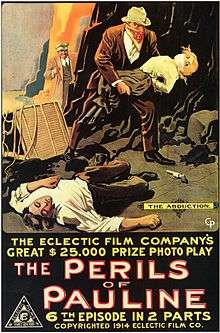Cliffhanger

A cliffhanger, or cliffhanger ending, is a plot device in fiction which features a main character in a precarious or difficult dilemma, or confronted with a shocking revelation at the end of an episode[1] of serialized fiction. A cliffhanger is hoped to ensure the audience will return to see how the characters resolve the dilemma.
Some serials end with the caveat "To Be Continued…" or "The End?" In movie serials and television series the following episode sometimes begins with a recap sequence.
Origin
The term "cliffhanger" is considered to have originated with the serialised version of Thomas Hardy's A Pair of Blue Eyes (which was published in Tinsley's Magazine between September 1872 and July 1873) in which Henry Knight, one of the protagonists, is left literally hanging off a cliff.[2]
Serial media
Cliffhangers were especially popular in 1920s and 1930s serials when movie theaters filled the cultural niche later primarily occupied by television. Cliffhangers are often used in television series, especially soap operas that end each episode on a cliffhanger. Prior to the early 1980s, season-ending cliffhangers were rare on U.S. television. The first such season-ender on U.S. TV was in the comedy send-up of soap operas Soap in 1978. Several Australian soap operas, which went off air over summer, such as Number 96, The Restless Years, and Prisoner, ended each year with major and much publicized catastrophe, such as a character being shot in the final seconds of the year's closing episode.
Cliffhangers were rare on American television before 1980, as television networks preferred the flexibility of airing episodes in any order. The phenomenal success of the 1980 "Who shot J.R.?" third season-ending cliffhanger of Dallas, and the "Who Done It" fourth-season episode that finally solved the mystery, contributed to the cliffhanger becoming a common storytelling device on television.[3] Another notable cliffhanger was the "Moldavian Massacre" on Dynasty in 1985, which fueled speculation throughout the summer months regarding who lived or died when almost all the characters attended a wedding in the country of Moldavia, only to have revolutionaries topple the government and machine-gun the entire wedding party.
The two main ways for cliffhangers to keep readers/viewers coming back is to either involve characters in a suspenseful, possibly life-threatening situation, or to feature a sudden shocking revelation.
Cliffhangers are also used to leave open the possibility of a character being killed off due to the actor not continuing to play the role.
Cliffhangers are also sometimes deliberately inserted by writers who are uncertain whether a new series or season will be commissioned, in the hope that viewers will demand to know how the situation is resolved. Such was the case with the second season of Twin Peaks, which ended in a cliffhanger similar to the first season with a high degree of uncertainty about the fate of the protagonist, but the cliffhanger could not save the show from being canceled, resulting in the unresolved ending.
The cliffhanger has become a genre staple (especially in comics, due to the multi-part storylines becoming the norm instead of self-contained stories). To such a degree, in fact, that series writers no longer feel they have to be immediately resolved, or even referenced, when the next episode is shown,[4] variously because the writer didn't feel it was "a strong enough opener,"[5] or simply "couldn't be bothered."[6] The heavily serialized television drama True Blood has become notorious for cliffhangers. Not only do the seasons conclude with cliffhangers, but almost every episode finishes at a cliffhanger directly after or during a highly dramatic moment.[7]
Commercial breaks can be a nuisance to script writers because some sort of incompleteness or minor cliffhanger should be provided before each to stop the viewer from changing channels during the commercial break. Sometimes a series ends with an unintended cliffhanger caused by a very abrupt ending without a satisfactory dénouement, but merely assuming that the viewer will assume that everything sorted itself out.
Sometimes a movie, book, or season of a television show will end with the defeat of the main villain before a second, evidently more powerful villain makes a brief appearance (becoming the villain of the next film). Occasionally an element other than a villain is also used to tease at a sequel.
See also
References
- ↑ Some are placed before commercial breaks
- ↑ Diniejko,, Andrzej. "Thomas Hardy's A Pair of Blue Eyes As a Cliffhanger with a Post-Darwinian Message". The Victorian Web. Retrieved 27 January 2017.
- ↑ Meisler, Andy (1995-05-07). "TELEVISION; When J. R. Was Shot The Cliffhanger Was Born". The New York Times. Retrieved June 14, 2012.
- ↑ "The IT Crowd: Tramps Like Us". Noise to Signal. Retrieved 2012-11-21.
- ↑ "…and we like tramps! « Why, That\’s Delightful!". Whythatsdelightful.wordpress.com. Retrieved 2012-11-21.
- ↑ Ben Falk (2007-08-24). "One of the IT Crowd | Manchester Evening News - menmedia.co.uk". Manchester Evening News. Retrieved 2012-11-21.
- ↑ "'True Blood' Finale Sets Up More Cliffhangers". Buddytv.com. 2009-09-14. Retrieved 2012-11-21.
Books
- Vincent Fröhlich: Der Cliffhanger und die serielle Narration. Bielefeld: Transcript Verlag, 2015. ISBN 978-3837629767.